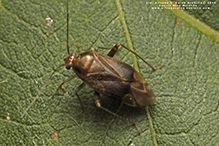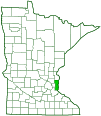Sources
Biodiversity occurrence data published by: Minnesota Biodiversity Atlas (accessed through the Minnesota Biodiversity Atlas Portal, bellatlas.umn.edu. Accessed 12/24/2025).
(Neolygus communis)
Conservation • Description • Habitat • Ecology • Distribution • Taxonomy

not listed
not listed
not listed
Pear plant bug is a small true bug. It occurs in northern United States, in southern Canada, and in Alaska. Nymphs feed on developing fruits and leaves of a wide variety of shrubs and trees. On dogwood and winterberry, they feed on young leaves. On pear, apple, and other fruit trees, they feed on developing fruits. Feeding causes raised, russet-colored bumps, which affect the marketability of the fruit. Adults also feed on fruit, and are a vector for the disease pear blight. Pear plant bug is a serious agricultural pest in states and provinces in the east where fruit is grown.
Adults are 3⁄16″ to ¼″ (5.11 to 5.95 mm) in length and 1⁄16″ to ⅛″ (2.10 to 2.66 mm) wide. The body is elongated oval, and soft. It is variable in color, making identification difficult. The base color may be brownish-yellow or brownish-green, in either case with dark, reddish-brown markings. On each side of the body there is a reddish stripe, but this is not visible from above.
The head is oblique. There are two large compound eyes and no simple eyes (ocelli). The eyes are not stalked and do not rise much above the top of the head. There is a prominent raised ridge (carina) between the eyes. The top of the head (vertex) is broad, brownish-yellow or brownish-green, and marked with transverse reddish bars. The back of the head is very short, so that the eyes almost touch the pronotum. The mouth parts take the form of a long beak (rostrum) that projects downward and is optimized for piercing and sucking. The rostrum does not extend beyond the first segment (coxa) of the hind legs. It has four segments. The first segment is as long or longer than the head. The antennae are long, slender, and thread-like. They have 4 segments. The first segment is only sparsely hairy. The second segment is very long, longer than the pronotum is wide at the base.. It is dark brown to brownish-gray and not swollen. The third segment is dark brown, the fourth segment brownish-gray.
The exoskeletal plate covering the thorax (pronotum) is widest at the base, much narrower behind the head, and not noticeably swollen in the middle. It has a distinct, exposed collar. The lateral margins are not flattened. There is a prominent, small, rounded bump (callus) at the front outer angle on each side of the pronotum behind the collar. Behind each callus there is a distinct black ray that nearly reaches the rear margin of the pronotum. The surface of the pronotum is shiny and very finely pitted (punctate). It may be greenish in front and tinted brown behind, or entirely brown on dark individuals.
The exoskeletal plate between the wing bases (scutellum), is large, triangular, greenish, and tinted with brown, entirely brown on dark individuals. There are two pairs of wings. The front wings (hemelytra) are longer than the hind wings and a little longer than the body. They are held flat over the body when at rest. They are dark brown to grayish-brown and are densely covered with hairs. They have a thickened, leathery part at the base and a thin membranous part at the tip with a clear dividing line between the two. The thickened part is comprised of the narrow area (clavus) behind the scutellum when the wings are closed; the broad marginal area (corium); and the outer margin on the corium (embolium). At the end of the corium there is a small but distinct triangular area (cuneus). The tip of the embolium and the rear half of the corium are darker. The cuneus is clear and is tinged with yellow. The tip of the cuneus is sometimes darkened. The membranous part at the wingtip is darkened. It has two closed cells defined by pale veins. On dark individuals the hemelytra are almost entirely dark brown. The hindwings are completely thin and membranous.
The legs are long, slender, and greenish to yellowish. On the hind legs the third segment (femur) is usually distinctly reddish. There is a pair of reddish rings near the tip of The femurs on the hind leg, and sometimes also on the middle leg. The fourth segment (tibia) of each leg is armed with numerous small spines. Each spine rises from a black spot. The last part of each leg (tarsus), corresponding to the foot, has 3 segments. The first tarsal segment on the hind leg is shorter than the second and third segments together. There is a pair of claws at the end of the third segment.
3⁄16″ to ¼″ (5.11 to 5.95 mm)
Xxxxxxxxxxx
Xxxxxxxxxxxxxx
One generation per year: Nymphs in early May, adults from early June to the end of July
The female inserts eggs into crevices in the bark on a host tree or shrub. The eggs overwinter and hatch the following spring in early May. Males die in early July soon after mating. Females live to the end of July.
Developing fruits and young leaves

Xxxxxxxxxxx
Order
Hemiptera (True bugs, Hoppers, Aphids, and Allies)
Suborder
Heteroptera (True Bugs)
Infraorder
Cimicomorpha
Superfamily
Miroidea
Family
Subfamily
Mirinae
Tribe
Mirini
Genus
Genus
This species is one of about 300 originally placed in the genus Lygus in 1917. It was named Lygus communis and placed in Group VI (communis group, subgroup Neolygus). In 1952 Neolygus was raised to subgenus status. In 1963 most Lygus species, including communis, were transferred to the genus Lygocoris. In 2002 all of the subgenera were raised to species level, leaving just two species in Lygocoris.
Lygocoris communis
Lygocoris novascotiensis
Lygus communis
green apple bug
pear plant bug
Glossary
Corium
The thickened basal portion of the front wing that lies between the clavus and the membrane of insects in the family Hemiptera. Plural: coria.
Cuneus
The triangular, hardened, horn-like tip of the forewing of a plant bug (family Miridae).
Femur
On insects and arachnids, the third, largest, most robust segment of the leg, coming immediately before the tibia. On humans, the thigh bone.
Hemelytron
The forewing of true bugs (order Hemiptera), thickened at the base and membranous at the tip. Plural: hemelytra.
Ocellus
Simple eye; an eye with a single lens. Plural: ocelli.
Pronotum
The exoskeletal plate on the upper side of the first segment of the thorax of an insect.
Punctate
Dotted with pits (punctures), translucent sunken glands, or colored spots of pigment.
Rostrum
The stiff, beak-like projection of the carapace or prolongation of the head of an insect, crustacean, or cetacean.
Scutellum
The exoskeletal plate covering the rearward (posterior) part of the middle segment of the thorax in some insects. In Coleoptera, Hemiptera, and Homoptera, the dorsal, often triangular plate behind the pronotum and between the bases of the front wings. In Diptera, the exoskeletal plate between the abdomen and the thorax.
Tarsus
On insects, the last two to five subdivisions of the leg, attached to the tibia; the foot. On spiders, the last segment of the leg. Plural: tarsi.
Tibia
The fourth segment of an insect leg, after the femur and before the tarsus (foot). The fifth segment of a spider leg or palp. Plural: tibiae.
Vertex
The upper surface of an insect’s head.
This button not working for you?
Simply email us at info@MinnesotaSeasons.com.
Attach one or more photos and, if you like, a caption.



This button not working for you?
Simply email us at info@MinnesotaSeasons.com.
Attach a video, a YouTube link, or a cloud storage link.
